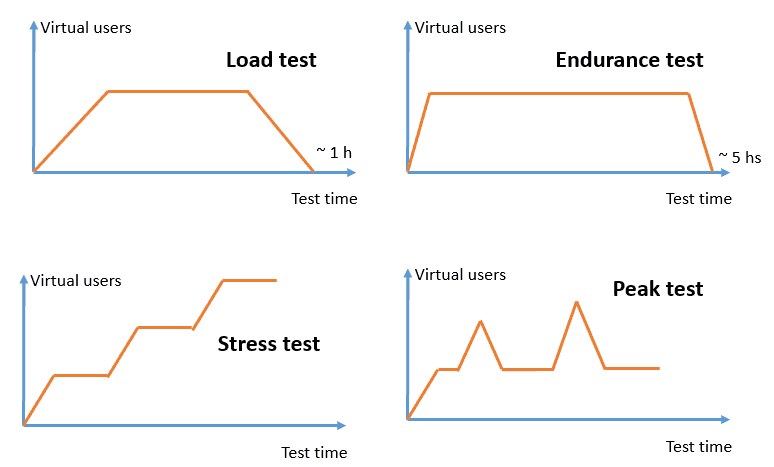Have you ever had those days when too many people want something from you at the same time? When your inbox is flooded by so many questions and requests that you just freeze and stop doing anything at all?
Everyone has those days now and then and so does your software application or website. Today we will discuss why performance testing is crucial part of the software development life cycle.


What is Performance Testing?
Performance testing assesses the speed, responsiveness, and stability of a software program, network, device, or web or mobile application under a specific workload.
It’s essential to identify, rectify, and prevent performance issues that might negatively impact the user experience.
Performance testing reveals how a system behaves and responds during various situations. A system may run very well with only 1,000 concurrent users, but how would it run with 100,000? In terms of performance, we wish to achieve high speed, scalability, and stability of the system.
Types of Performance Tests
There are several types of performance tests in which each simulates a different possible user scenario.
Through these tests, we can gauge the types of performance and the application’s overall capability to handle traffic, providing valuable insights into potential system bottlenecks and vulnerabilities, and thereby ensuring the applications’ performance remains optimal even under heavy loads.
The figure below demonstrates how some of them work.


Why is it Important to do Performance Testing?


Speed
Users expect pages to load as quickly as possible and when they don’t, satisfaction decreases. Users can even experience heightened levels of stress when pages take too long to load.
When the website glitches or takes forever to load during the middle of a financial transaction, users may become frustrated and lose trust. According to a Harris 2015 poll, 46% of shoppers have said that they will never return to a slow site.
Perceived Load Times
Even if your web page is loading at a reasonable rate, users perceive load times as slower than they actually are. A misperception of time makes us even more impatient.
That’s just another reason why decreasing load time is important, even if on paper it loads quickly, it may not be perceived that way.
Another reason why you should care about page speed is because Google’s algorithm favors faster websites. It takes into account page speed for both web and mobile browsing. It’s Google’s world, and we have to play by its rules to come out on top of its search results.
Revenue Generation
Most importantly, the faster the website, the more revenue it will generate.
Sites that load fastest have a competitive advantage. Since everything on the internet is just a click away, it is vital to have quick load times to keep customers on your site and not your competitors.
“Two hundred and fifty milliseconds, either slower or faster, is close to the magic number for competitive advantage on the Web.” Harry Shum, Executive Vice President of Technology and Research, Microsoft.
Here are some real examples of positive outcomes from increasing page speed:
- BBC: The BBC found that by reducing page load times by just 1 second, they saw an additional 10% of users visiting their site from search engines. This increase in traffic led to higher ad revenue and user engagement.
- Pinterest: Pinterest revamped its mobile website to make it faster and more responsive. The result was a 40% increase in mobile engagement and a 15% increase in sign-ups.
- AliExpress: The online marketplace AliExpress improved its website’s performance, leading to a 10.5% increase in orders and a 27% increase in conversion rates.
Scalability
Scalability tests are extremely important if you want more users to interact with your system. How many more users can you support if you add another CPU to the database server? How long will the page take to load with this addition? These are all important things to know.
Ensuring System Reliability and Responsiveness
Scalability isn’t just a nice-to-have feature; it’s essential for maintaining the seamless operation of your system as the number of users interacting with it surges.
By conducting scalability stress tests, you gain valuable insights into how your system behaves under mounting loads. This preparation ensures that your system remains responsive and robust, even when user numbers skyrocket.
Optimizing Resource Allocation
Adding more CPUs to your database server is a common strategy for enhancing performance. Scalability tests serve as a guiding light in this endeavor.
They unveil the impacts of these hardware enhancements on your system’s efficiency and response times, empowering you to make informed decisions about resource allocation.
Predicting User Capacity and Response Times
It’s crucial to know how many more users your system can gracefully accommodate with each hardware upgrade or performance optimization.
Scalability tests not only provide answers to this query but also offer insights into how these changes influence the time it takes for your pages to load. Armed with this knowledge, you can manage user experiences more effectively.
Balancing Performance and Budget
Your goal isn’t just to make your system faster but to do so in a cost-effective manner. Scalability tests play a pivotal role in optimizing your infrastructure expenses.
They guide you in making choices that enhance application performance while respecting budget constraints, whether that means vertical scaling, horizontal scaling, or a blend of both.
Identifying Bottlenecks and Performance Limitations
By conducting scalability tests, you can unveil potential bottlenecks and limitations within your system. Armed with this knowledge, you can proactively address these issues, fine-tune system components, and implement performance optimizations.
Eliminating bottlenecks is the key to maintaining a consistently smooth user experience.
In sum, scalability testing is as crucial as ensuring your system’s speed. It’s your strategic tool for preparing your system to handle increased user interaction, fine-tuning your resource allocation decisions, and providing the best user experience while balancing your budget constraints.
This proactive approach keeps your system responsive, reliable, and cost-effective, even as your user base expands.
Stability
Your application’s ability to function consistently is a non-negotiable requirement. In the digital age, downtime is not only inconvenient but can result in significant repercussions.
Understanding how your system performs under various conditions, especially during high-stress situations, is a critical aspect of ensuring its continued functionality.
Consider a scenario where your e-commerce website experiences a catastrophic failure on a day like Black Friday. This high-traffic shopping event demands flawless system performance, and a failure at this critical juncture can be devastating.
For globally recognized companies, every minute of downtime can translate into substantial financial losses and severe reputational damage.
High-profile businesses, in particular, are under constant scrutiny, and even a brief interruption can turn into front-page news, tarnishing their image and customer trust.
Understanding System Limits: Stress Testing
Stress testing is a proactive measure that helps you comprehend your system’s limits. It answers critical questions about your system’s capacity, such as how many users it can accommodate before reaching its threshold.
Neglecting this assessment can have costly consequences, both in terms of lost revenue and potential damage to your reputation.
Stress testing serves as your safeguard against these risks, ensuring your system remains robust and reliable, regardless of when it faces challenging conditions.
Learn how to stress test a website in this article.
When should you do performance testing?
The question of when to conduct performance testing is pivotal in ensuring the success of any software development project.
Ideally, performance testing should be a central priority throughout the software development lifecycle. Here’s a closer look at the strategic timing for this essential testing phase:
Early Integration in Development
Performance testing should be introduced in the early stages of development, well before the software’s final release.
By incorporating effective performance testing back into the initial phases of development, you can identify and address potential issues, bottlenecks, and vulnerabilities much earlier in the process.
An early intervention not only helps in resolving issues when they are less complex but also significantly reduces the chances of more critical problems arising later.
Preventive Bug Identification
One of the primary objectives of performing performance testing early in the development cycle is to detect and address potential bugs and performance bottlenecks before they become critical.
Early identification enables development teams to proactively work on optimizing the system’s performance and improving its overall reliability. It’s a preventive measure that minimizes the risk of critical performance issues emerging post-release.
Enhancing User Satisfaction
By integrating your performance testing capabilities into the development process from the outset, you increase the likelihood of delivering a software product that meets or even exceeds user expectations.
Ensuring that your application is responsive, reliable, and fast right from the start enhances user satisfaction, which is essential for building a positive user base and maintaining your software’s reputation.
Cost and Time Efficiency
Performance testing early in development proves to be a cost-effective and time-efficient strategy. Addressing issues at the beginning of the development process is typically less complex and less expensive than making substantial changes or fixes after a product’s release.
Early performance testing helps and ultimately saves you both time and money by preventing costly rework and post-launch support.
In conclusion, the strategic timing for performance testing is clear: it should be an integral part of your software development process right from the start.
The proactive approach of early performance testing offers numerous benefits, from preventing critical issues and bugs to enhancing user satisfaction and overall cost-efficiency.
By making performance testing a priority throughout your development cycle, you lay the foundation for a successful, high-performing software product.
Learn more about our solutions here and contact us to discuss how we can help you grow your business.


Tags In


Sofía Palamarchuk, Co-CEO at Abstracta
Related Posts
Is The System Actually Running Slow?
When a user says that “the system is slow” we would like to know: Is the system actually running slow or is it a matter of perception? Is the chronometer distorted or does the system, in fact, prevent the user from working in a normal…
Workload or Load Scenario in Performance Testing
In load tests we simulate the workload that an application will have in production, counting the concurrent users accessing the application, the tests cases that will be executed, and the frequency of executions by users, among other things. The concept of workload or load scenario…
Search
Contents
Categories
- Acceptance testing
- Accessibility Testing
- AI
- API Testing
- Development
- DevOps
- Fintech
- Functional Software Testing
- Healthtech
- Mobile Testing
- Observability Testing
- Partners
- Performance Testing
- Press
- Security Testing
- Software Quality
- Software Testing
- Test Automation
- Testing Strategy
- Testing Tools
- Work Culture







